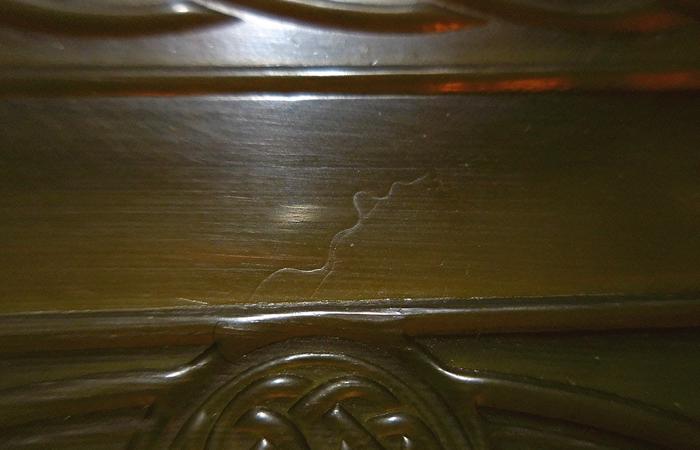Results 1 to 10 of 35
Thread: A method for pressing horn
Hybrid View
-
04-19-2018, 05:30 PM #1

One of my major problems in life is suffering from the delusion that I can pick up any skill I set my mind to, so I imagine I could learn to do die-engraving. This is probably quite far from true, but I'm willing to try.
My other problem is that I will cheerfully spend weeks making a faster method to do a thing that takes hours, so the CNC machined die is awfully appealing (and of course I'm sure I could figure out how to do that without having ever tried to do that).
You begin to see how I get in trouble.
I've got to think that one of the keys to getting the plates to cut as well as form is having the whole jig slathered in some kind of lube. I recall Neil saying they used tallow. There was that bit about the liquidized keratin dripping out of the molds.
But I'm also excited by the idea of boiling transparent horn in neatsfoot oil to improve its clarity -- that way lies some very good faux tortoise. I have everything I need for that experiment except blanks with good clarity. They're all streaky.
Whoa! That is a neat trick with the tape!-Zak Jarvis. Writer. Artist. Bon vivant.
-
04-20-2018, 09:49 AM #2

Xnay on the "boiling" horn. I heated a slab yesterday, and took it to a little higher heat and longer period. When the micro bubbling stopped, I took it out to find that it had shrunk badly. Flat surface on top had a sunken lagoon in the middle, other flat had developed waviness, the edges were concave, and the whole piece wanted to revert to its curved memory. Not good. Seems that only slight treatment at lower temperatures and times has any value whatsoever.
-
The Following 2 Users Say Thank You to Oldnick For This Useful Post:
Gasman (08-06-2018), Voidmonster (04-20-2018)
-
04-20-2018, 11:03 AM #3Hones & Honing




- Join Date
- May 2005
- Location
- Saint Paul, Minnesota, United States
- Posts
- 8,023
- Blog Entries
- 1
Thanked: 2209
Thank you for posting this!
 It will inspire others to explore this lost art.
It will inspire others to explore this lost art.
Keep us updated please. Randolph Tuttle, a SRP Mentor for residents of Minnesota & western Wisconsin
Randolph Tuttle, a SRP Mentor for residents of Minnesota & western Wisconsin
-
-
04-20-2018, 01:28 PM #4
-
04-20-2018, 04:56 PM #5
-
04-20-2018, 05:30 PM #6

Oops, left out the word oil. 100 percent neatsfoot.
-
The Following User Says Thank You to Oldnick For This Useful Post:
Voidmonster (04-20-2018)
-
04-20-2018, 05:34 PM #7

Hmm. I wonder if that's related to temperature.
Also, I assume you found this? I had it bookmarked for when I got around to doing this.-Zak Jarvis. Writer. Artist. Bon vivant.
-
The Following User Says Thank You to Voidmonster For This Useful Post:
MikeT (08-06-2018)
-
04-20-2018, 10:18 PM #8
-
-
06-29-2018, 01:41 PM #9

Here is a link to some presses with internal heating elements:
heated+mold+vulcanizing
https:Arbe-Machine-Vulcanizer
Arbe-Machine-Vulcanizer-Jewelry-Casting
I recently found a similar but larger press as surplus at a university surplus sale for about $70, did not buy it as I don't have a shop anymore. They should be available in most areas new or used. Darn heavy beasties though so watch shipping costs!
YMMV.
~RichardLast edited by Geezer; 06-29-2018 at 01:55 PM.
Be yourself; everyone else is already taken.
- Oscar Wilde
-
The Following 4 Users Say Thank You to Geezer For This Useful Post:
MikeB52 (08-08-2018), MikeT (08-05-2018), randydance062449 (07-01-2018), tintin (06-29-2018)
-
07-31-2018, 07:07 PM #10Junior Member

- Join Date
- Sep 2014
- Location
- Galati , Romania
- Posts
- 7
Thanked: 14
-


 140Likes
140Likes LinkBack URL
LinkBack URL About LinkBacks
About LinkBacks

 . Anyway, I'm glad you are enjoying my explorations....jump in!
. Anyway, I'm glad you are enjoying my explorations....jump in!






 Reply With Quote
Reply With Quote

